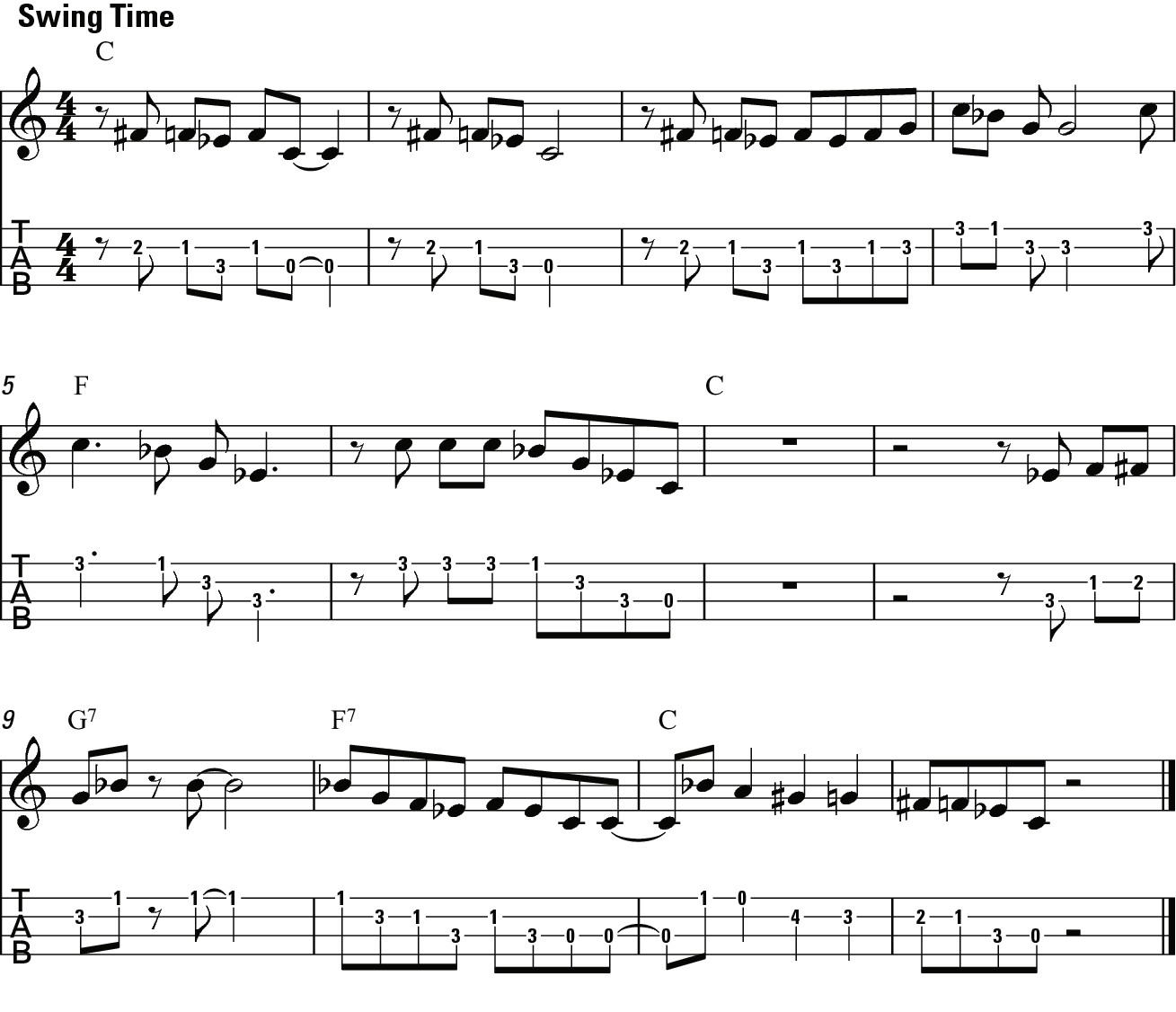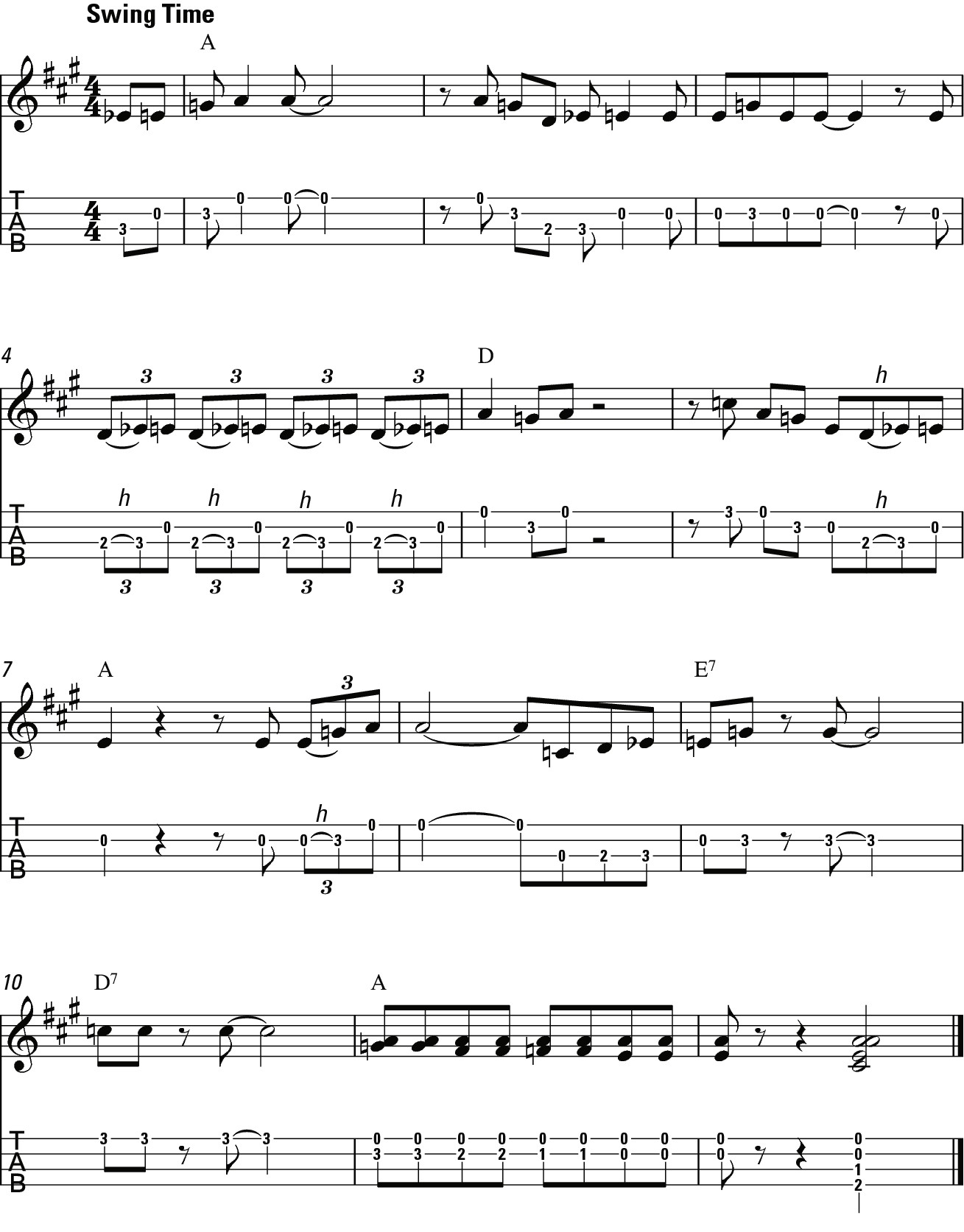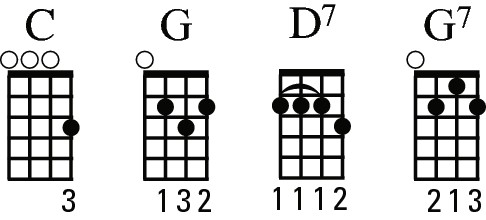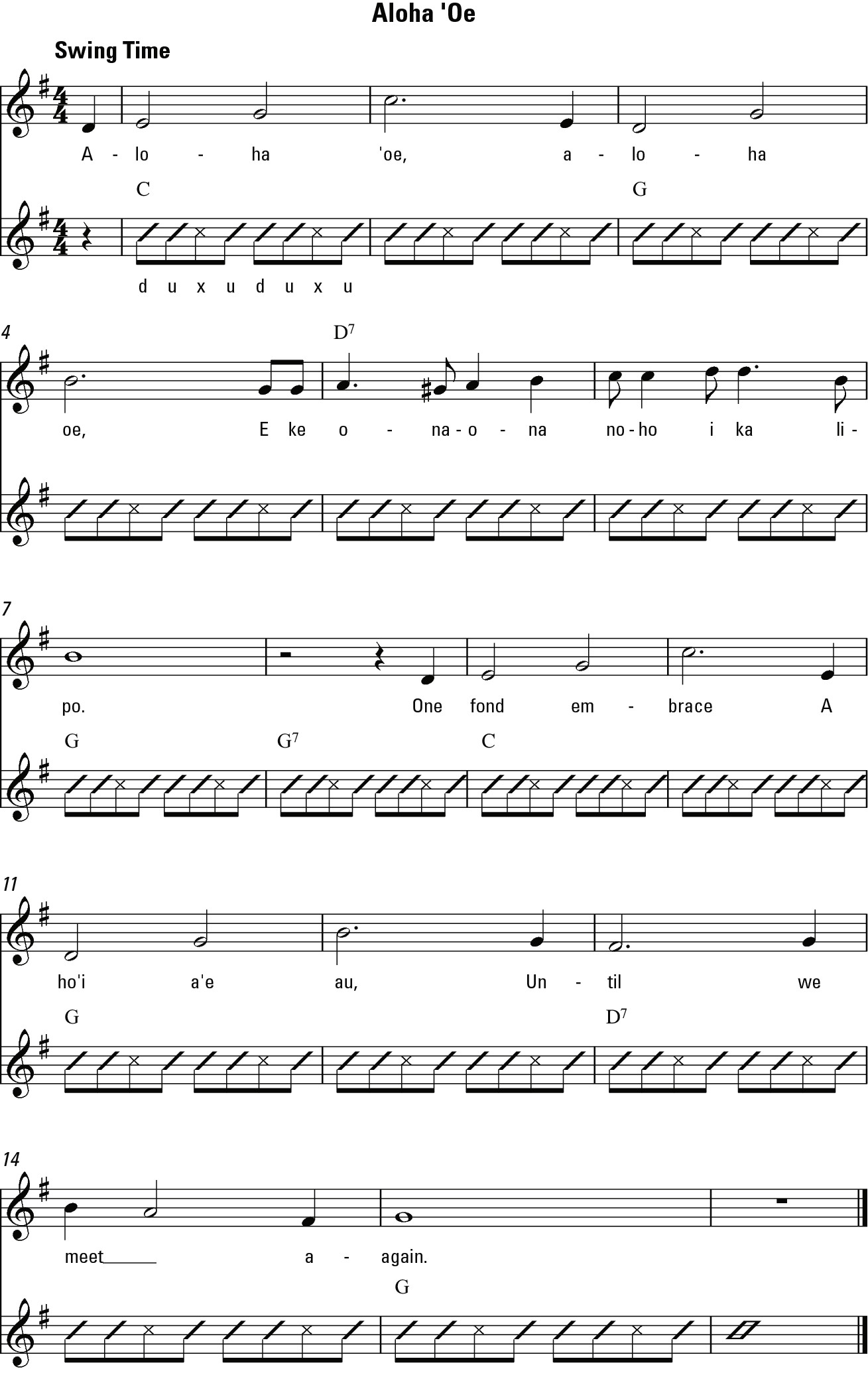Ukulele For Dummies (54 page)
Read Ukulele For Dummies Online
Authors: Alistair Wood

 Swing:
Swing:
Make sure that the first half of the beat is longer than the second so that you get the off-kilter rhythm. Swing time is discussed more fully in Chapter 5.
 Rests:
Rests:
Whenever you see a rest (see Chapter 7 for rest notation) stop the note playing: if it's a fretted note, release it; if it's an open note, touch the string lightly to stop it ringing.
 Picking:
Picking:
Fingerpick both solos, with your thumb on the C-string, index finger on the E-string and middle finger on the A-string.
Blues solo in C
 The solo in Figure 12-22 (Track 72) is quite laid-back and makes use of a common blues solo standby: it starts by repeating and reworking a phrase. The first bar sets up the phrase, the second shortens it and the third extends it with a run up the strings.
The solo in Figure 12-22 (Track 72) is quite laid-back and makes use of a common blues solo standby: it starts by repeating and reworking a phrase. The first bar sets up the phrase, the second shortens it and the third extends it with a run up the strings.
Another aspect of the solo is the long rests: these are really important because they give the notes room to breathe.
 You may well be tempted to add an extra phrase in the long pause in bars seven and eight, but don't. If you try to crowbar one in, you can hear how cluttered the result sounds.
You may well be tempted to add an extra phrase in the long pause in bars seven and eight, but don't. If you try to crowbar one in, you can hear how cluttered the result sounds.
The solo breaks away from the blues scale at the end to incorporate the traditional descending ending.
Figure 12-22:
Blues solo using the C blues scale.

Blues solo in A
 The solo in Figure 12-23 (Track 73) goes at a pretty fast tempo. The key is A and the solo is based around the A blues scale.
The solo in Figure 12-23 (Track 73) goes at a pretty fast tempo. The key is A and the solo is based around the A blues scale.
 Watch out for the introduction. The solo part starts one beat before the backing comes in. So if you're playing along with the backing track of Track 73, listen to the opening four beats of the metronome and start playing on the fourth click of the next bar.
Watch out for the introduction. The solo part starts one beat before the backing comes in. So if you're playing along with the backing track of Track 73, listen to the opening four beats of the metronome and start playing on the fourth click of the next bar.
 A tricky part comes in bar four, where you have four sets of triplets (where one beat is divided into three notes). Practise this section repeatedly on its own until you can play it smoothly.
A tricky part comes in bar four, where you have four sets of triplets (where one beat is divided into three notes). Practise this section repeatedly on its own until you can play it smoothly.
The solo ends with a blues turnaround similar to that in the earlier Figure 12-12.
Figure 12-23:
Blues solo using the A blues scale.

Chapter 13
Saying âAloha' to the Hawaiian Style
In This Chapter
 Strumming like a Hawaiian
Strumming like a Hawaiian
 Turning around like a Hawaiian
Turning around like a Hawaiian
 Soloing on a beautiful Hawaiian tune
Soloing on a beautiful Hawaiian tune
A
lthough in theory I could've written this book without dedicating a chapter to the music of the ukulele's birthplace, doing so would be rather silly! The uke and Hawaiian music developed together, and so of course Hawaiian tunes â whether lilting waltzes or a rapid strums â always sound great on the ukulele.
This chapter covers the distinctive characteristics of Hawaiian ukulele playing, illustrated by traditional Hawaiian songs.
Strumming in the Hawaiian Way
Hawaiian strumming features two common characteristics:
 Swing time:
Swing time:
The first half of the beat is extended and the second half shortened. You can find a full discussion of swing time in Chapter 5.
 Accent on the off-beats:
Accent on the off-beats:
Instead of putting the emphasis on the first and third beats (as is common in European music), Hawaiian music emphasises the second and fourth beats.
Just adding these two elements can transform a very simple strum into something far more interesting. You can use a couple of ways to accent these off-beats:
 Give them an extra hard strum (as described in Chapter 5).
Give them an extra hard strum (as described in Chapter 5).

 Add a muted-strum chnk on the second and fourth beat, as shown in Figure 13-1 and on Track 74 (again, turn to Chapter 5 for a full description of chnking).
Add a muted-strum chnk on the second and fourth beat, as shown in Figure 13-1 and on Track 74 (again, turn to Chapter 5 for a full description of chnking).
Figure 13-1:
Typical Hawaiian strum notation.

You can use this strum to play the most famous Hawaiian song of all time: âAloha Oe'. It was written by Hawaiian Queen Liliâuokalani and has since become a symbol of Hawaii, cropping up in films from Elvis's
Blue Hawaii
to
Lilo and Stitch
.
 Figure 13-2 contains the chord diagrams for this song and the full chord chart is in Figure 13-3. The song is Track 75.
Figure 13-2 contains the chord diagrams for this song and the full chord chart is in Figure 13-3. The song is Track 75.
Figure 13-2:
Chord diagrams for âAloha Oe'.

Another way to get that Hawaiian sound is to cram three strums into a single beat using
triplet strumming
. Usually, of course, strums have a maximum of two strums in a beat (a down and an up).
These three strums do create a slight problem because you have only two strumming directions: up and down. As a result, you have two options: open up a portal in the spaceâtime continuum and strum in four dimensions or get creative with your fingers. As creating wormholes is slightly beyond the scope of this book (pick up a copy of
Time Travel and Impossible Astrophysics For Dummies
for a full discussion), I concentrate on the second method!
Figure 13-3:
âAloha Oe' chord chart.
